
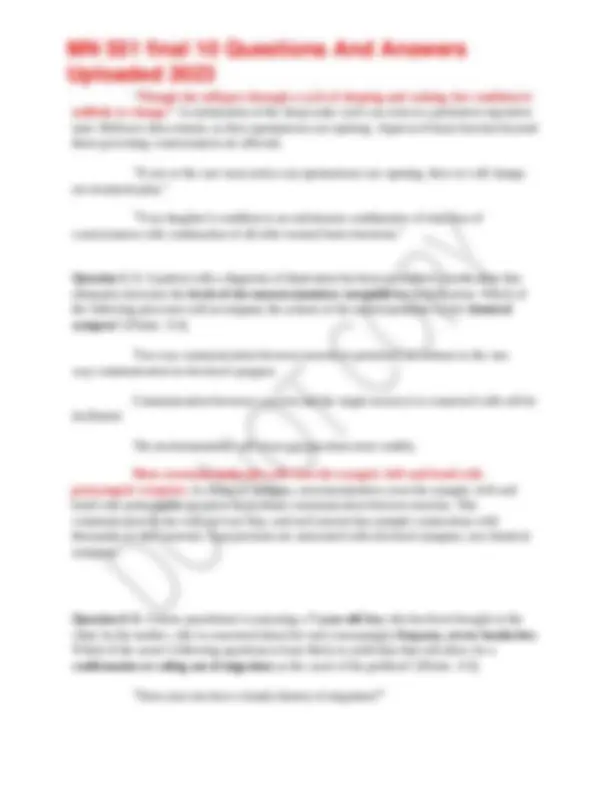
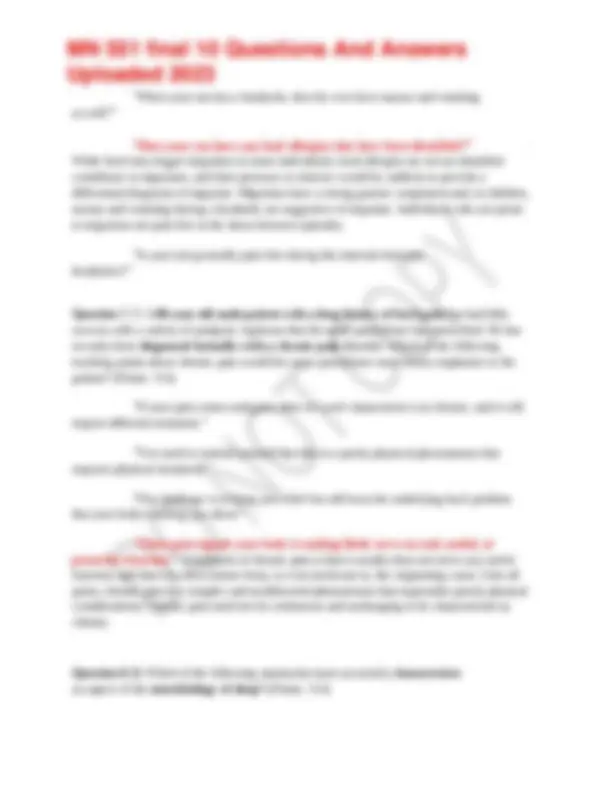
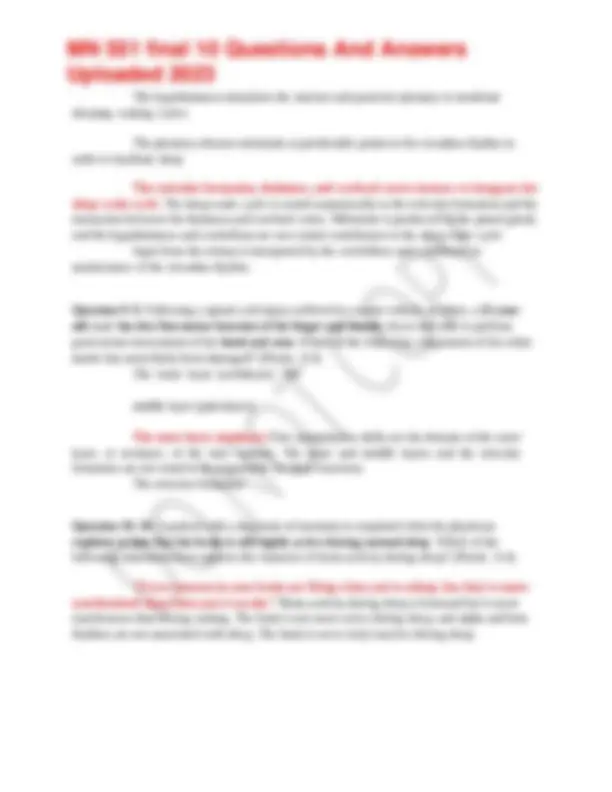
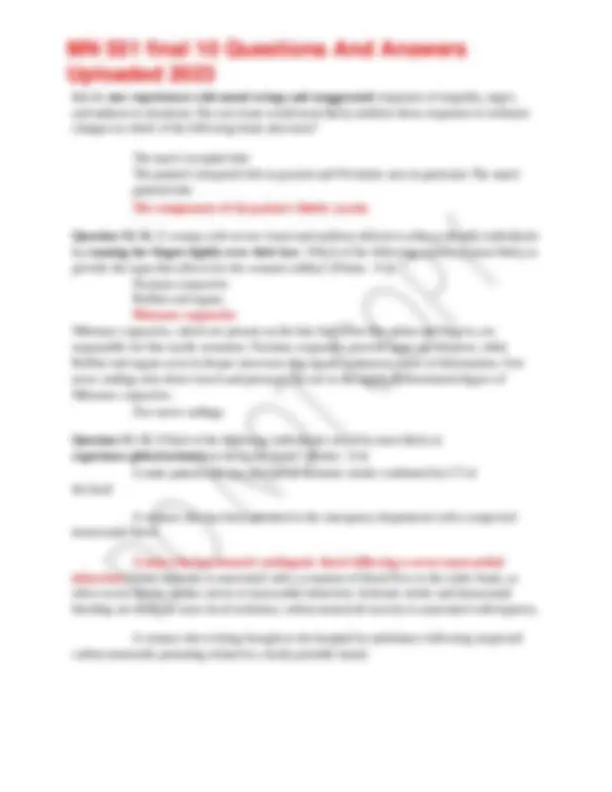
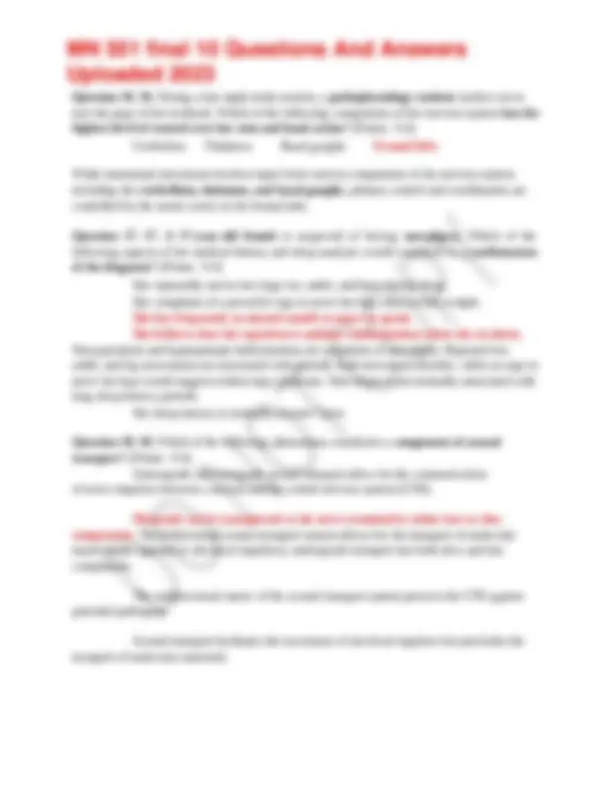
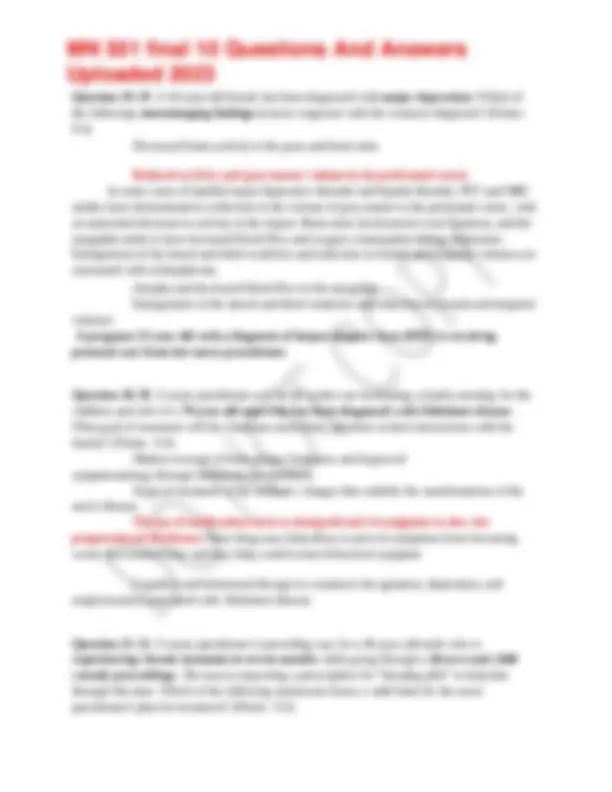
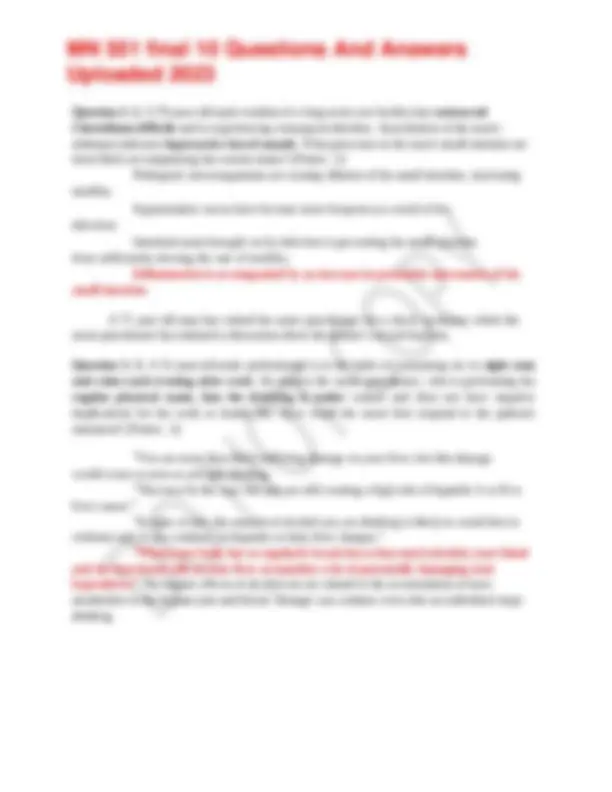
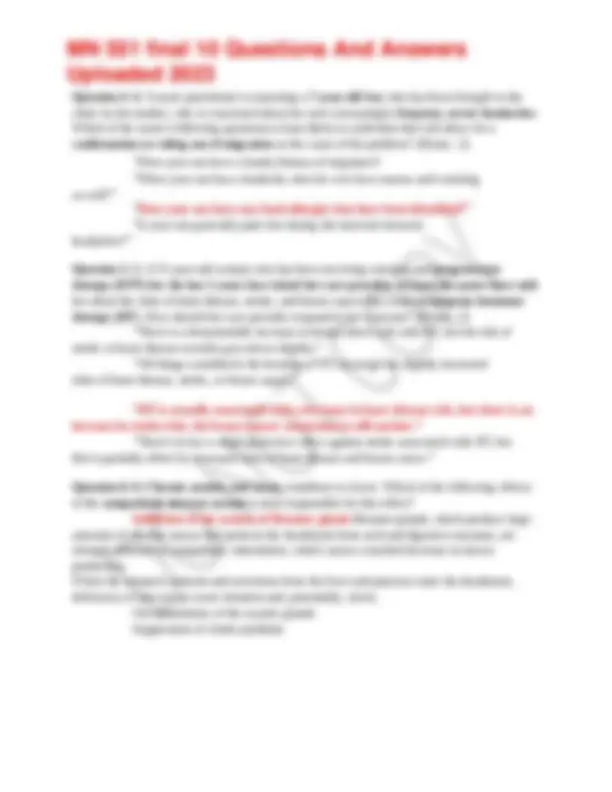
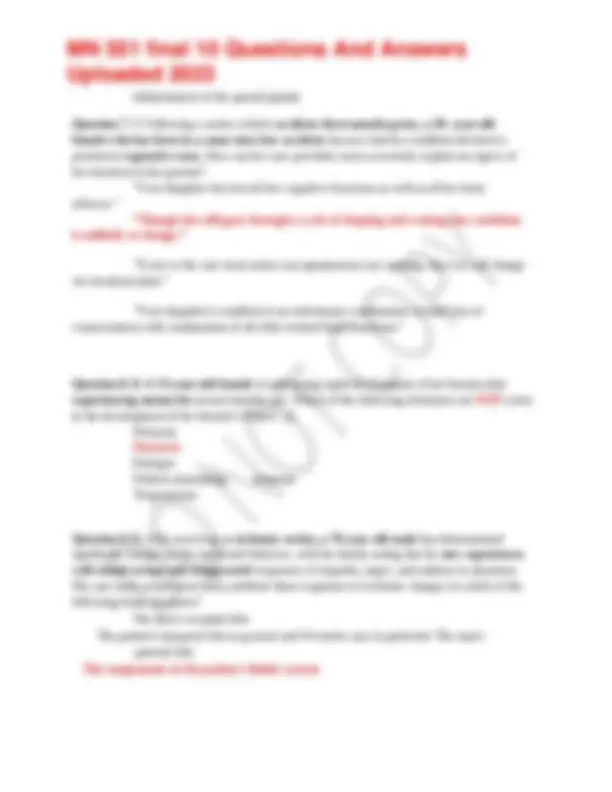
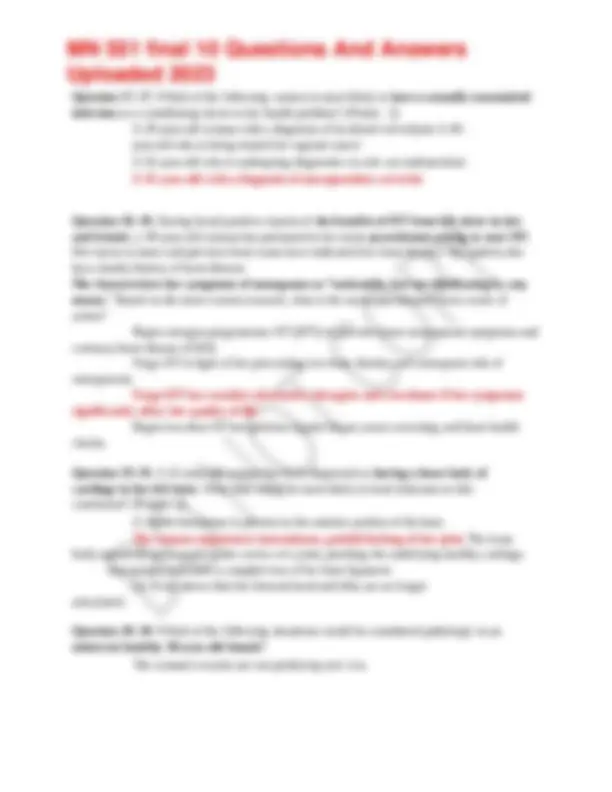
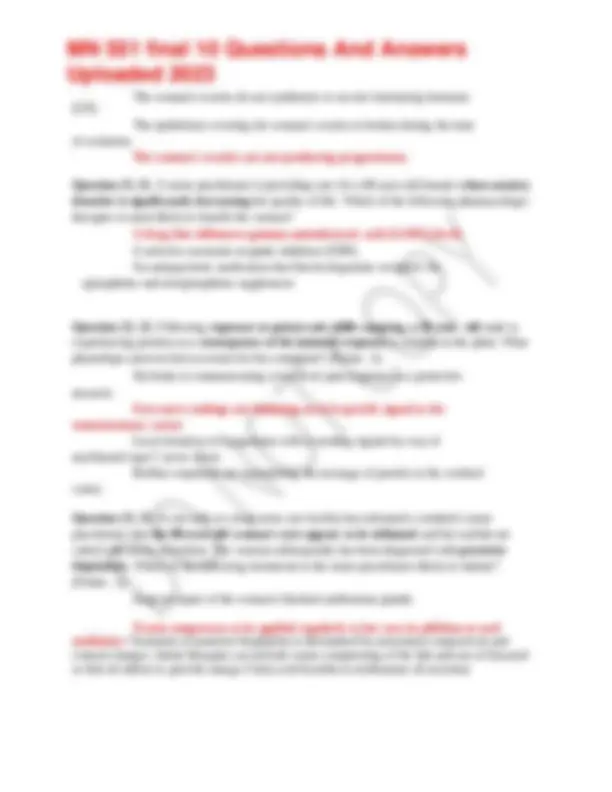
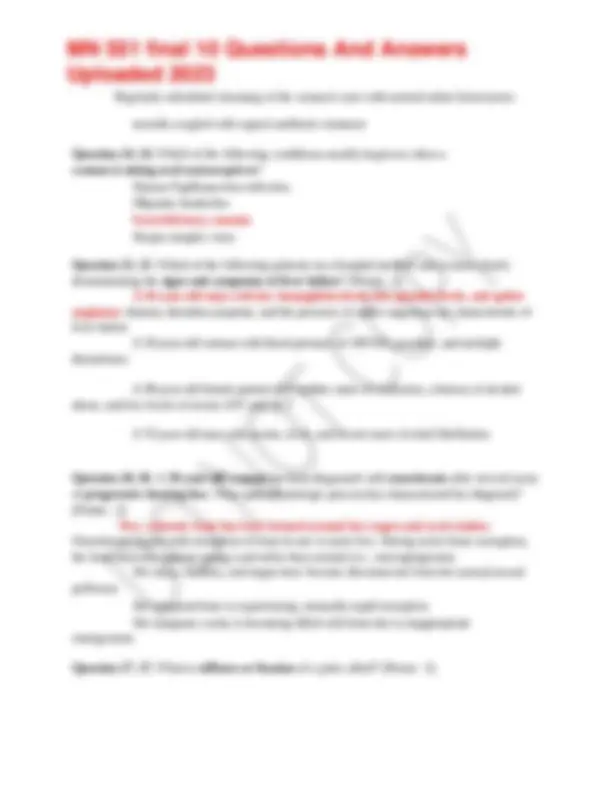
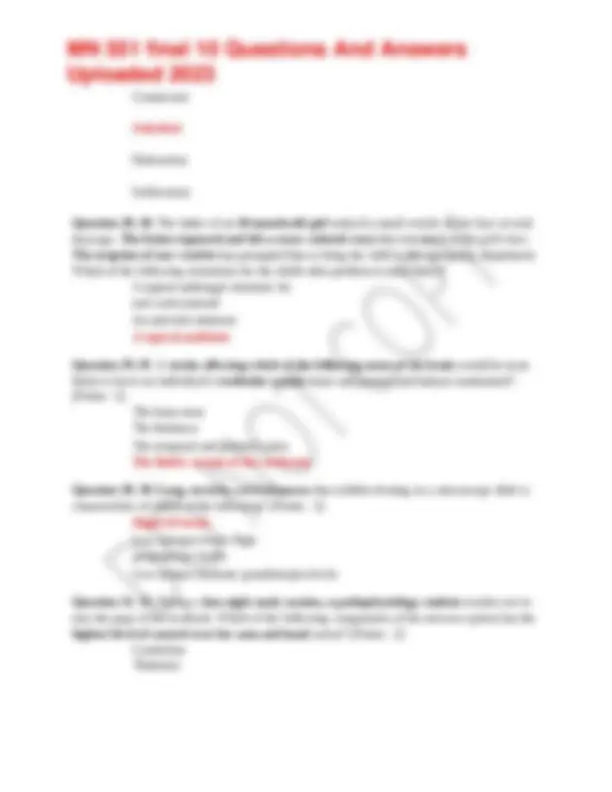
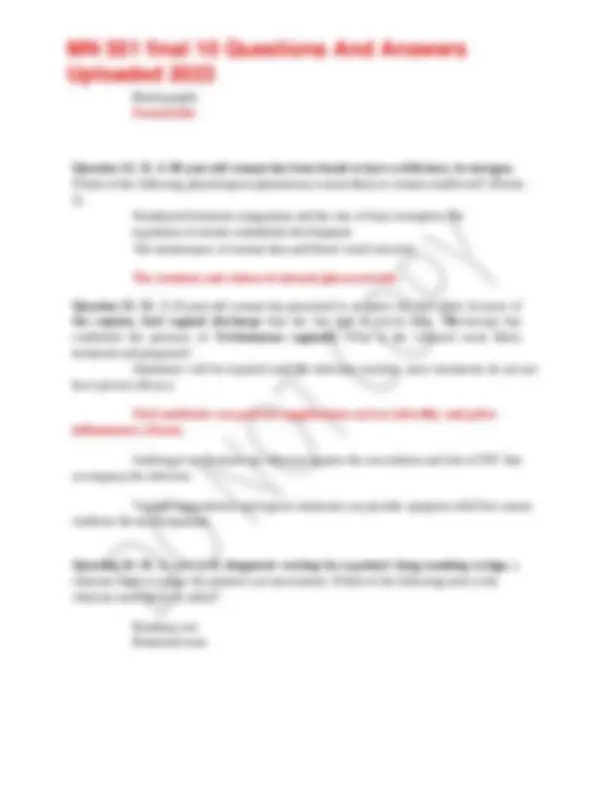
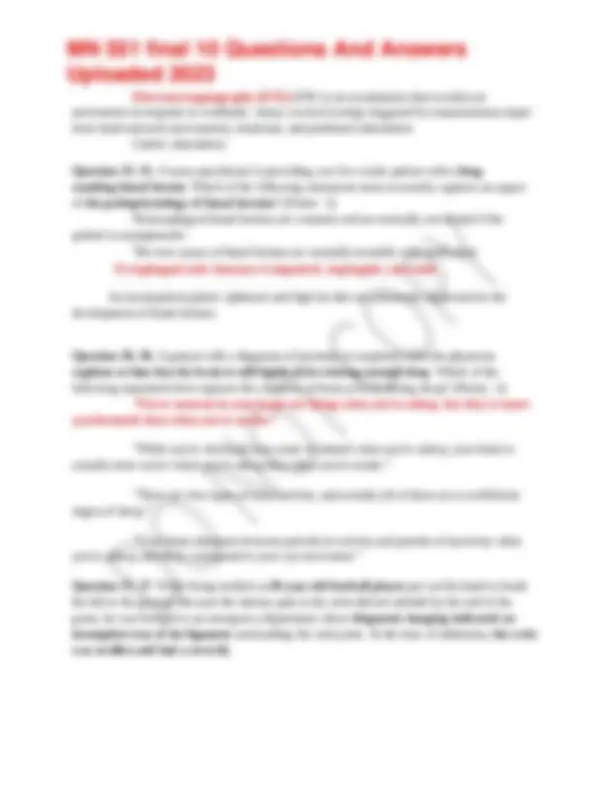
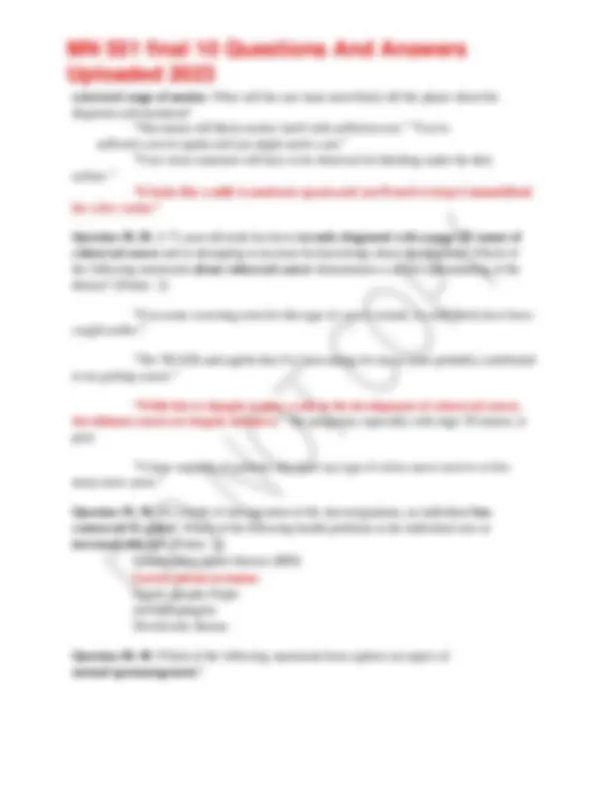
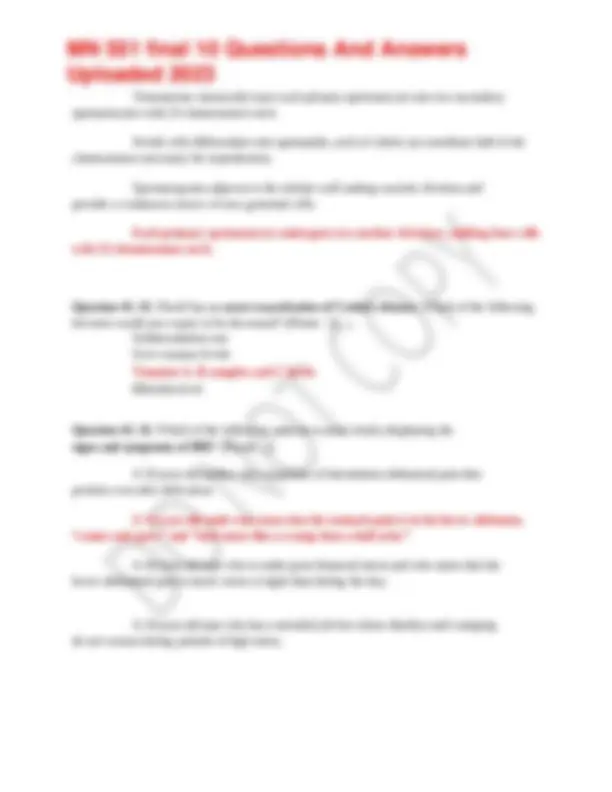
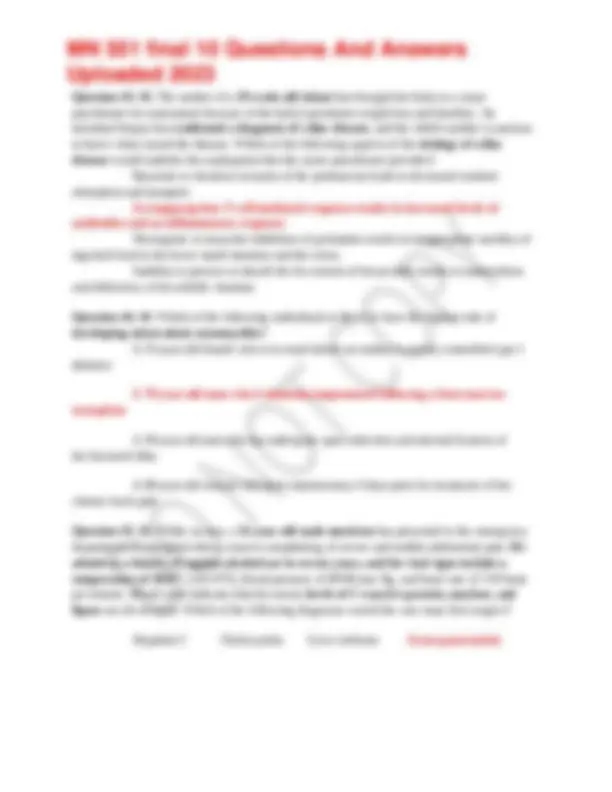
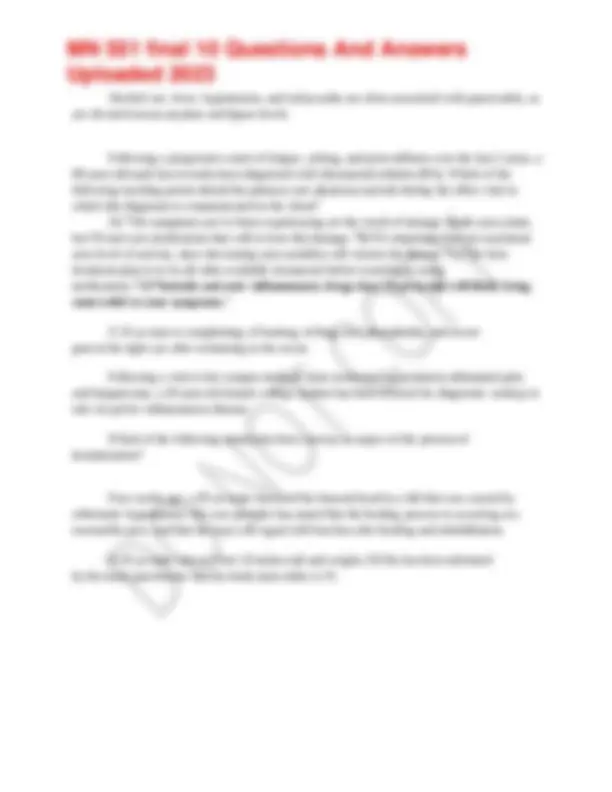


Study with the several resources on Docsity

Earn points by helping other students or get them with a premium plan


Prepare for your exams
Study with the several resources on Docsity

Earn points to download
Earn points by helping other students or get them with a premium plan
Community
Ask the community for help and clear up your study doubts
Discover the best universities in your country according to Docsity users
Free resources
Download our free guides on studying techniques, anxiety management strategies, and thesis advice from Docsity tutors
MN 551 final 10 Questions And Answers Uploaded 2023 MN 551 final 10 Questions And Answers Uploaded 2023 MN 551 final 10 Questions And Answers Uploaded 2023MN 551 final 10 Questions And Answers Uploaded 2023MN 551 final 10 Questions And Answers Uploaded 2023MN 551 final 10 Questions And Answers Uploaded 2023
Typology: Exams
1 / 27

This page cannot be seen from the preview
Don't miss anything!




















Which of the following sexually active women most likely faces the highest risk of developing an ectopic pregnancy? A 42 yo female patient with a long standing history of chronic nausea and vomiting but a near insatiable appetite has had her symptoms Which of the following individuals demonstrates a health problem with his or her axial skeleton? QUESTION 1. The unique clinical presentation of a three-month-old infant in the emergency department leads the care team to suspect botulism. Which of the following assessment questions posed to the parents is likely to be most useful in the differential diagnosis? (Points : 0.4) “Have you ever given your child any honey or honey-containing products?” Botulism in infants is frequently attributable to honey. Family history is not a relevant consideration given the bacterial etiology, and mold and chemical cleaning products are not known to predispose to botulism toxicity. “Is there any family history of neuromuscular diseases?” “Has your baby ever been directly exposed to any chemical cleaning products?” “Is there any mold in your home that you know of?” Question 2. 2. A nurse practitioner is providing care for a 68-year-old female whose anxiety disorder is significantly decreasing her quality of life. Which of the following pharmacologic therapies is most likely to benefit the woman? (Points : 0.4) A drug that influences gamma-aminobutyric acid (GABA) levels GABA is often implicated in anxiety disorders, and benzodiazepines address this neurotransmitter. An MAO inhibitor increases the concentration of serotonin and norepinephrine. MAO inhibitors are occasionally prescribed for depression not responding to SSRIs and would not
be indicated for an anxiety disorder. Calcium channel blockers are good for lowering BP and minimizing arterial spasms but are usually not prescribed for anxiety. A selective serotonin reuptake inhibitor (SSRI) An antipsychotic medication that blocks dopamine receptors An epinephrine and norepinephrine supplement A 60 woman who is 11 years menopausal has presented to the emergency department stating “I haven’t had my period in years, but lately Ive been bleeding again A 20 year old male has been diagnosed with testicular cancer and is seeking information Question 3. 3. A 51-year-old has been admitted to a rehabilitation center after hospital treatment for an ischemic stroke. Which of the following aspects of the patient's history would not be considered to have contributed to his stroke? (Points : 0.4) He was diagnosed with type 2 diabetes eight years ago Elevated cholesterol Blood pressure that is normally 120/80 African American race, male gender, hypertension, and diabetes are all well-documented risk factors for stroke. Anemia, autoimmune disorders like rheumatoid arthritis, and the use of corticosteroids are not noted to predispose to stroke. The patient is an African American Male History of sickle cell anemia Question 4. 4. Following a motor vehicle accident three months prior , a 20- year-old female who has been in a coma since her accident has now had her condition declared a persistent vegetative state. How can her care providers most accurately explain an aspect of her situation to her parents? (Points : 0.4) “Your daughter has lost all her cognitive functions as well as all her basic reflexes.”
“When your son has a headache, does he ever have nausea and vomiting as well?” “Does your son have any food allergies that have been identified?” While food may trigger migraines in some individuals, food allergies are not an identified contributor to migraines, and their presence or absence would be unlikely to provide a differential diagnosis of migraine. Migraines have a strong genetic component and, in children, nausea and vomiting during a headache are suggestive of migraine. Individuals who are prone to migraines are pain free in the times between episodes. “Is your son generally pain free during the intervals between headaches?” Question 7. 7. A 60-year-old male patient with a long history of back pain has had little success with a variety of analgesic regimens that his nurse practitioner has prescribed. He has recently been diagnosed formally with a chronic pain disorder. Which of the following teaching points about chronic pain would his nurse practitioner most likely emphasize to the patient? (Points : 0.4) “If your pain comes and goes, then we won't characterize it as chronic, and it will require different treatment.” “You need to remind yourself that this is a purely physical phenomenon that requires physical treatment.” “Our challenge is to bring you relief but still treat the underlying back problem that your body is telling you about.” “These pain signals your body is sending likely serve no real, useful, or protective function .” A hallmark of chronic pain is that it usually does not serve any useful function, and that it is often remote from, or even irrelevant to, the originating cause. Like all pains, chronic pain is a complex and multifaceted phenomenon that supersedes purely physical considerations. Chronic pain need not be continuous and unchanging to be characterized as chronic. Question 8. 8. Which of the following statements most accurately characterizes an aspect of the neurobiology of sleep? (Points : 0.4)
The hypothalamus stimulates the anterior and posterior pituitary to modulate sleeping–waking cycles. The pituitary releases melatonin at predictable points in the circadian rhythm in order to facilitate sleep. The reticular formation, thalamus, and cerebral cortex interact to integrate the sleep–wake cycle. The sleep-wake cycle is rooted anatomically in the reticular formation and the interaction between the thalamus and cerebral cortex. Melatonin is produced by the pineal gland, and the hypothalamus and cerebellum are not central contributors to the sleep-wake cycle Input from the retinas is interpreted by the cerebellum and contributes to maintenance of the circadian rhythm. Question 9. 9. Following a spinal cord injury suffered in a motor vehicle accident, a 22-year- old male has lost fine motor function of his finger and thumb, but is still able to perform gross motor movements of his hand and arm. Which of the following components of his white matter has most likely been damaged? (Points : 0.4) The inner layer (archilayer) The middle layer (paleolayer) The outer layer (neolayer) Fine manipulation skills are the domain of the outer layer, or neolayer, of the tract systems. The inner and middle layers and the reticular formation are not noted to be responsible for these functions. The reticular formation Question 10. 10. A patient with a diagnosis of insomnia is surprised when his physician explains to him that his brain is still highly active during normal sleep. Which of the following statements best captures the character of brain activity during sleep? (Points : 0.4) “ Fewer neurons in your brain are firing when you're asleep, but they're more synchronized than when you're awake.” Brain activity during sleep is lessened but is more synchronous than during waking. The brain is not more active during sleep, and alpha and beta rhythms are not associated with sleep. The brain is never truly inactive during sleep.
Chronic anxiety and stress contribute to ulcers. Which of the following effects of the sympathetic nervous system is most responsible for this effect? A patient with a history of endocrine disorder exhibits signs and symptoms of hormone deficiency. A 43 yo male patient has presented to the emergency department with vomiting that he claims is of sudden onset. A 39 yo male patient has been recently diagnosed with primary hypogonadism. A 24 year old woman undergoing a primatial screening test is found to have elevated levels of AST, ALT, and IgG but no antibody specific markers for viral hepatitis. Which of the following diagnostic findings would be a clinician’s priority for further investigation and possible medical intervention? A 30 yo woman has sought care because of her recurrent photophobia, tearing and eye irritation. Question 12. 12. Which of the following factors is most responsible for the fact that prefrontal lobotomy is no longer a common treatment for mental illness? (Points : 0.4) Individuals treated by lobotomy have difficulty interpreting somatic, visual, and auditory information. Lobotomy inhibits the individual's ability to add perception and meaning to sensory information. Severing connections between the brain and its prefrontal areas inhibits problem solving and results in a loss of ambition. Loss of communication to and from the prefrontal cortex changes, but ultimately exacerbates, symptoms of mental illness. Question 13. 13. After surviving an ischemic stroke, a 79-year-old male has demonstrated significant changes in his emotional behavior, with his family noting
that he now experiences wide mood swings and exaggerated responses of empathy, anger, and sadness to situations. His care team would most likely attribute these responses to ischemic changes in which of the following brain structures? The man's occipital lobe The patient's temporal lobe in general and Wernicke area in particular The man's parietal lobe The components of the patient's limbic system Question 14. 14. A woman with severe visual and auditory deficits is able to identify individuals by running her fingers lightly over their face. Which of the following sources is most likely to provide the input that allows for the woman's ability? (Points : 0.4) Pacinian corpuscles Ruffini end organs Meissner corpuscles Meissner corpuscles, which are present on the hair-free areas like palms and fingers, are responsible for fine tactile sensation. Pacinian corpuscles provide input on vibration, while Ruffini end organs exist in deeper structures that signal continuous states of deformation. Free nerve endings also detect touch and pressure, but not to the highly differentiated degree of Meissner corpuscles. Free nerve endings Question 15. 15. Which of the following individuals would be most likely to experience global ischemia to his or her brain? (Points : 0.4) A male patient who has just had an ischemic stroke confirmed by CT of his head A woman who has been admitted to the emergency department with a suspected intracranial bleed A man who has entered cardiogenic shock following a severe myocardial infarction Global ischemia is associated with a cessation of blood flow to the entire brain, as often occurs during cardiac arrest or myocardial infarction. Ischemic stroke and intracranial bleeding are likely to cause focal ischemia; carbon monoxide toxicity is associated with hypoxia. A woman who is being brought to the hospital by ambulance following suspected carbon monoxide poisoning related to a faulty portable heater
Question 19. 19. A 44-year-old female has been diagnosed with major depression. Which of the following neuroimaging findings i s most congruent with the woman's diagnosis? (Points : 0.4) Decreased brain activity in the pons and brain stem Reduced activity and gray matter volume in the prefrontal cortex In some cases of familial major depressive disorder and bipolar disorder, PET and MRI studies have demonstrated a reduction in the volume of gray matter in the prefrontal cortex, with an associated decrease in activity in the region. Brain stem involvement is not common, and the amygdala tends to have increased blood flow and oxygen consumption during depression. Enlargement of the lateral and third ventricles and reduction in frontal and temporal volumes are associated with schizophrenia. Atrophy and decreased blood flow in the amygdala Enlargement of the lateral and third ventricles and reduction in frontal and temporal volumes A pregnant 23 year old with a diagnosis of herpes simplex virus (HSV) is receiving prenatal care from her nurse practitioner. Question 20. 20. A nurse practitioner and social worker are facilitating a family meeting for the children and wife of a 79-year-old man who has been diagnosed with Alzheimer disease. What goal of treatment will the clinicians most likely prioritize in their interactions with the family? (Points : 0.4) Modest reversal of brain plaque formation and improved symptomatology through cholinesterase inhibitors Surgical treatment of the ischemic changes that underlie the manifestations of the man's disease The use of medications such as donepezil and rivastigmine to slow the progression of the disease These drugs may help delay or prevent symptoms from becoming worse for a limited time and may help control some behavioral symptom Cognitive and behavioral therapy to counteract the agitation, depression, and suspiciousness associated with Alzheimer disease. Question 21. 21. A nurse practitioner is providing care for a 40-year-old male who is experiencing chronic insomnia in recent months while going through a divorce and child custody proceedings. The man is requesting a prescription for “sleeping pills” to help him through this time. Which of the following statements forms a valid basis for the nurse practitioner's plan for treatment? (Points : 0.4)
Sedative and hypnotic drugs will not provide safe relief of the man's health problem. The man is suffering from primary insomnia. Melatonin supplements will be the safest and most effective long-term pharmacological treatment. Behavioral therapies, counseling, and education may be of some use to the patient. Question 22. 22. The parents of a 15-year-old boy are frustrated by his persistent inability to fall asleep at a reasonable hour at night , as well as the extreme difficulty that they have in rousing him in the morning. While sleepy after waking, the son claims not to feel drowsy after lunch or in the evening. What is the most likely classification of the boy's sleep disorder? (Points : 0.4) Delayed sleep phase syndrome (DSPS) The teen's sleep patterns are characteristic of DSPS. Non-24-hour sleep-wake syndrome is characterized by a sleep cycle that greatly exceeds 24 hours, and ASPS is the opposite of DSPS. Chronic insomnia would likely include afternoon and evening drowsiness Non–24-hour sleep–wake syndrome Advanced sleep phase syndrome (ASPS) Chronic insomnia Question 23. 23. A clinician is conducting an assessment of a male patient suspected of having a disorder of motor function. Which of the following assessment findings would suggest a possible upper motor neuron (UMN) lesion? (Points : 0.4) The patient has decreased deep tendon reflexes. The patient displays increased muscle tone. UMNs typically produce increased muscle tone, while hyporeflexia, muscle atrophy, and weakness in the distal portion of limbs are more commonly indicative of LMN lesions. The patient's muscles appear atrophied. The patient displays weakness in the distal portions of his limbs. Question 24. 24. A student is feeling inside her backpack to find her mobile phone, which has fallen to the bottom, and there are a number of items in the bag in addition to the phone. Which of the following components of somatosensory
Question 2. 2. A 79-year-old male resident of a long-term care facility has contracted Clostridium difficile and is experiencing consequent diarrhea. Auscultation of the man's abdomen indicates hyperactive bowel sounds. What processes in the man's small intestine are most likely accompanying his current status? (Points : 2) Pathogenic microorganisms are causing dilation of his small intestine, increasing motility. Segmentation waves have become more frequent as a result of his infection. Intestinal stasis brought on by infection is preventing his small intestine from sufficiently slowing the rate of motility. Inflammation is accompanied by an increase in peristaltic movements of his small intestine. A 71 year old man has visited his nurse practitioner for a check up during which the nurse practitioner has initiated a discussion about the patient’s sexual function. Question 3. 3. A 51-year-old male professional is in the habit of consuming six to eight rum and cokes each evening after work. He assures the nurse practitioner, who is performing his regular physical exam, that his drinking is under control and does not have negative implications for his work or family life. How could the nurse best respond to the patient's statement? (Points : 2) “You are more than likely inflicting damage on your liver, but this damage would cease as soon as you quit drinking. “That may be the case, but you are still creating a high risk of hepatitis A or B or liver cancer.” “In spite of that, the amount of alcohol you are drinking is likely to result first in cirrhosis and, if you continue, in hepatitis or fatty liver changes.” “When your body has to regularly break down that much alcohol, your blood and the functional cells in your liver accumulate a lot of potentially damaging toxic byproducts.” The hepatic effects of alcohol use are related to the accumulation of toxic metabolites in the hepatocytes and blood. Damage can continue even after an individual stops drinking
Question 4. 4. A nurse practitioner is assessing a 7-year-old boy who has been brought to the clinic by his mother, who is concerned about her son's increasingly frequent, severe headaches. Which of the nurse's following questions is least likely to yield data that will allow for a confirmation or ruling out of migraines as the cause of his problem? (Points : 2) “Does your son have a family history of migraines? “When your son has a headache, does he ever have nausea and vomiting as well?” “ Does your son have any food allergies that have been identified?” “Is your son generally pain free during the intervals between headaches?” Question 5. 5. A 51-year-old woman who has been receiving estrogen and progesterone therapy (EPT) for the last 5 years has visited her care provider because her peers have told her about the risks of heart disease, stroke, and breast cancer that could accompany hormone therapy (HT ). How should her care provider respond to her concerns? (Points : 2) “There is a demonstrable increase in breast cancer risk with HT, but the risk of stroke or heart disease actually goes down slightly.” “All things considered, the benefits of HT outweigh the slightly increased risks of heart disease, stroke, or breast cancer.” “HT is actually associated with a decrease in heart disease risk, but there is an increase in stroke risk; the breast cancer connection is still unclear.” “There's in fact a slight protective effect against stroke associated with HT, but this is partially offset by increased rates of heart disease and breast cancer.” Question 6. 6. Chronic anxiety and stress contribute to ulcers. Which of the following effects of the sympathetic nervous system is most responsible for this effect? Inhibition of the actions of Brunner glands Brunner glands, which produce large amounts of alkaline mucus that protects the duodenum from acid and digestive enzymes, are strongly affected by sympathetic stimulation, which causes a marked decrease in mucus production. Where the stomach contents and secretions from the liver and pancreas enter the duodenum, deficiency of mucus can cause irritation and, potentially, ulcers. Overstimulation of the oxyntic glands Suppression of cholecystokinin
Question 10. 10. A 29-year-old woman has been trying for many months to become pregnant, and fertilization has just occurred following her most recent ovulation. What process will now occur that will differentiate this ovulatory cycle from those prior? (Points : 2) Human chorionic gonadotropin will be produced, preventing luteal regression. The remaining primary follicles will provide hormonal support for the first 3 months of pregnancy. The corpus luteum will atrophy and be replaced by corpus albicans. The basal layer of the endometrium will be sloughed in preparation for implantation. Question 11. 11. A patient with a history of an endocrine disorder exhibits signs and symptoms of hormone deficiency. Which of the following processes would the patient's care team most likely rule out first as a contributing factor? (Points : 2) The patient's target cells lack sufficient receptors for the hormone in question. Hormone production is sufficient, but affinity on the part of the target cells is lacking. The process of down-regulation has resulted in decreased hormone sensitivity. Up-regulation has increased the sensitivity of the body to particular hormone levels. Question 12. 12. John presents to the clinic with complaints of scrotal heaviness. Your assessment reveals swelling of the testicle and warm scrotal skin. What would your diagnosis be? (Points : 2) Cryptorchidism Orchitis Testicular torsion Epididymitis Question 13. 13. The parents of a 15-year-old boy are frustrated by his persistent inability to fall asleep at a reasonable hour at night , as well as the extreme difficulty that they have in rousing him in the morning. While sleepy after waking,
the son claims not to feel drowsy after lunch or in the evening. What is the most likely classification of the boy's sleep disorder? (Points : 2) Delayed sleep phase syndrome (DSPS) Non– 24-hour sleep–wake syndrome Advanced sleep phase syndrome (ASPS) Chronic insomnia Question 14. 14. Following the identification of low levels of T3 and T4 coupled with the presence of a goiter , a 28-year-old female has been diagnosed with Hashimoto thyroiditis. In light of this diagnosis, which of the following assessment results would constitute an unexpected finding? (Points : 2) The presence of myxedema in the woman's face and extremities Recent weight gain despite a loss of appetite and chronic fatigue Coarse, dry skin and hair with decreased sweat production Increased white cell count and audible crackles on chest auscultation Question 15. 15. Following a spinal cord injury suffered in a motor vehicle accident, a 22- year-old male has lost fine motor function of his finger and thumb, but is still able to perform gross motor movements of his hand and arm. Which of the following components of his white matter has most likely been damaged? The inner layer (archilayer) The middle layer (paleolayer) The outer layer (neolayer) The reticular formation Question 16. 16. An 11-year-old boy with skin lesions characteristic of ringworm on his trunk h as been brought to the family's primary care provider by his mother. Which of the following aspects of the clinician's assessment relates most directly to the suspected diagnosis? Previous infection with other parasitic worms Potential contact with the fungus from pets or other children Allergic reactions to drugs and environmental substances The child's infanthood immunization history
The woman's ovaries do not synthesize or secrete luteinizing hormone The epithelium covering the woman's ovaries is broken during the time of ovulation. The woman's ovaries are not producing progesterone. Question 21. 21. A nurse practitioner is providing care for a 68-year-old female whose anxiety disorder is significantly decreasing her quality of life. Which of the following pharmacologic therapies is most likely to benefit the woman? A drug that influences gamma-aminobutyric acid (GABA) levels A selective serotonin reuptake inhibitor (SSRI) An antipsychotic medication that blocks dopamine receptors An epinephrine and norepinephrine supplement Question 22. 22. Following exposure to poison oak while camping, a 20-year- old male is experiencing pruritus as a consequence of his immune response to irritants in the plant. What physiologic process best accounts for his complaint? (Points : 2) His body is communicating a low-level pain response as a protective measure. Free nerve endings are initiating an itch-specific signal to the somatosensory cortex Local irritation of Langerhans cells is sending signals by way of myelinated type C nerve fibers. Ruffini corpuscles are transmitting the message of pruritis to the cerebral cortex. Question 23. 23. A care aide at a long-term care facility has informed a resident's nurse practitioner that the 80-year-old woman's eyes appear to be inflamed and her eyelids are caked with sticky secretions. The woman subsequently has been diagnosed with posterior blepharitis. Which of the following treatments is the nurse practitioner likely to initiate? (Points : 2) Surgical repair of the woman's blocked meibomian glands Warm compresses to be applied regularly to her eyes in addition to oral antibiotics Treatment of posterior blepharitis is determined by associated conjunctival and corneal changes. Initial therapies can include warm compressing of the lids and use of flaxseed or fish oil tablets to provide omega-3 fatty acid benefits to meibomian oil secretion
Regularly scheduled cleansing of the woman's eyes with normal saline Intravenous steroids coupled with topical antibiotic ointment Question 24. 24. Which of the following conditions usually improves when a woman is taking oral contraceptives? Human Papillomavirus infection Migraine headaches Iron deficiency anemia Herpes simplex virus Question 25. 25. Which of the following patients on a hospital medical unit is most clearly demonstrating the signs and symptoms of liver failure? (Points : 2) A 44-year-old man with low hemoglobin levels, low platelet levels, and spider angiomas Anemia, thrombocytopenia, and the presence of spider angiomas are characteristic of liver failure A 50-year-old woman with blood pressure of 189/103, jaundice, and multiple thromboses A 68-year-old female patient with sudden onset of confusion, a history of alcohol abuse, and low levels of serum AST and ALT A 55-year-old man with ascites, fever, and recent onset of atrial fibrillation Question 26. 26. A 29-year-old woman has been diagnosed with otosclerosis after several years of progressive hearing loss. What pathophysiologic process has characterized her diagnosis? (Points : 2) New, sclerotic bone has been formed around her stapes and oval window. Otosclerosis begins with resorption of bone in one or more foci. During active bone resorption, the bone structure appears spongy and softer than normal (i.e., osteospongiosis) Her incus, malleus, and stapes have become disconnected from her normal neural pathways Her temporal bone is experiencing unusually rapid resorption Her tympanic cavity is becoming filled with bone due to inappropriate osteogenesis. Question 27. 27. What is stiffness or fixation of a joint called? (Points : 2)